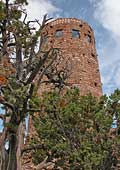
|
|
Download Options
| Image Name | Width x Height | Size |
|---|---|---|
| SIA0996.jpg | 451 x 656 | 94K |
| SIA0996.jpg | 846 x 1230 | 309K |
| SIA0996.jpg | 1707 x 2481 | 973K |
Caption
Build a structure that provides the widest possible view of Grand Canyon yet harmonizes with its setting: this was architect Mary Colter's goal when the Fred Harvey Company hired her in 1930 to design a gift shop and rest area at Desert View. Colter's answer was the Watchtower.
A perfectionist, Colter scrutinized every detail, down to the placement of nearly every stone. Each stone was handpicked for size and appearance. Weathered faces were left untouched to give the tower an ancient look. With a lavish, highly publicized dedication ceremony, the Watchtower opened in May 1933.
The Indian Watchtower is at the eastern end of the south rim of the Grand Canyon. From a distance the building's silhouette looks like the Anasazi watchtower it was meant to mimic. In actual size the tower is considerably larger than any known Anasazi tower. In plan the structure is composed of one enormous circle at the north, a small circle at the south, an gently arced forms connecting the two. The largest circle and the arced portions are the sections of that building that are just one story in height. The smaller circular plan is for the tower itself, more than five stories high. The building sits out on a promontory overlooking the Grand Canyon.
The most noteworthy aspect of the exterior is the stonework--a variety of uncoursed rubble below and coursed sandstone above, with decorative patterns of triangular stones adding architectural interest directly below the tower's parapet and other bands of color masonry adding even more visual interest. Colter's use of texture in the masonry creates a visual depth. Large walls sections of the tower, for instance, have a relatively smooth finish that in places is broken up by slightly larger stones protruding from the wall surface. Fenestration in the tower is irregular--tiny windows or those with irregular shapes--with the exception of the observation area at the top of the structure where large trapezoids of plate glass allow the viewer to see the surrounding countryside in all directions. Colter's careful massing of forms added more architectural emphasis to the tower.
The main entrance into the structure leads into the largest room of the building, originally known as the kiva room, that is circular in plan. The ceiling is made up of logs salvaged from the old Grand View Hotel on Horseshoe Mesa at the Canyon. The logs are laid in a pattern found in prehistoric native American architecture and still used in some Indian structures today. A ladder from the center of the room leads up to an opening in the ceiling that looks functional but is actually false. A low, arched fireplace on one edge of the room has a small mantle and am enormous picture window directly above it where the chimney normally would be--the flue actually draws the smoke from an upper corner. The floor of this room is flagstone, and walls are stone. This room has undergone little change since construction. Directly above this room on the roof of this part of the structure is an outdoor observation deck. Other spaces on the first floor are used for sales areas, as this is, and a small amount of storage space. The kiva room contains heavy, rustic furnishings of large chunks of wood and rawhide, also included in this nomination.
The most architecturally impressive section of the building is undoubtedly the tower interior. The space is an open shaft surrounded by circular balconies edging the walls and small staircases that lead up to subsequent levels. Only the uppermost observation area has a complete floor area covering the circular plan, and large plate-glass windows overlooking the surrounding expanses of the vast southwest. The rooftop observation area, reached by a ladder of sturdy log construction, is closed to the public. The steel and concrete structure of this space is entirely plastered and all of the walls are covered with murals. The most distinct images, painted by Hopi artist Fred Kabotie depict various aspects of Hopi mythology and religious ceremonies. The other murals done by Fred Greer are more subtle in color and purposefully softer in detail, and are copies of prehistoric pictographs and petroglyphs. The tiny windows of the tower let in a minimal amount of light which adds to the cave- like, mystical atmosphere of the space. Experiencing the multiple levels and circular balconies and the hundreds of prehistoric images inundates the viewer with an overwhelming sense of the southwest.